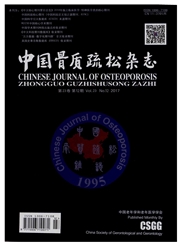

 中文摘要:
中文摘要:
目的探讨短期使用糖皮质激素对大鼠不同部位骨骼的形态结构和生物力学的影响。方法20只3月龄SD雌性大鼠随机分为2组:①正常对照组(Ctrl);②糖皮质激素组(dexamethasone,Dex)。每只大鼠适应性喂养1周后,灌胃6周,取左侧胫骨上段(proximal tibia metaphyses,PTM)和中段(middle part of tibia shaft,TX)进行骨形态计量学检测,取左侧股骨(Left Femur,LF)和第5腰椎(the 5th Lumbar Vertebra,LV5)进行骨生物力学检测。结果Ctrl组大鼠的体重随时间(6周)逐渐增加;而Dex组大鼠的体重增加缓慢,甚至出现体重下降的情况,两组大鼠的体重差异具有显著性。与Ctrl组比,Dex组大鼠软组织中:肝、脾、肾、子宫和胸腺重量显著性减少。骨形态计量学静态参数显示:与Ctrl组相比,Dex组大鼠TX段皮质骨的骨量明显降低,骨髓腔增大。动态参数显示:Dex组大鼠的骨内膜面荧光周长百分率、骨形成率明显降低,而骨吸收百分率增加;骨外膜面动态参数无显著性变化,两组大鼠PTM松质骨无论静态参数或动态参数与对照组比无统计学上的显著性变化。Dex也没有弱化LF和LV。的力学性能(最大载荷,最大应力,最大应变)。结论短期、少量使用Dex(45d,2.5mg·kg^-1,twiceperweek),仅使大鼠皮质骨丢失,由于几何形状的变化,并不改变生物力学的性能。以这种方式使用Dex,不仅不影响松质骨,也不改变大鼠的生物力学性能。此结论提示Dex短期使用对不同部位的骨骼影响不同,先出现皮质骨的变化。因此需要重视对糖皮质激素导致皮质骨变化的观察和研究。
 英文摘要:
英文摘要:
Objective To determine the different influence of Dexamethasone on cancellous and cortical bone by histomorphometry and biomechanicm in SD rats. Methods 20 3-month-old SD female rats were randomly divided into two groups:① normal control group (Ctrl); ② glucocorticoid group (dexamethasoue, Dex). Each rat was adaptive feeding 1 week before Dex administration 6 weeks. The left tibia (proximal tibia metaphyses, PTM) and middle ( middle part of tibia shaft, TX) were taken for bone histomorphometry in the experiment, the left side of the femur ( Left Femur, LF) and fifth lumbar vertebrae (the 5th Lumbar Vertebra, LVs ) were taken for bone biomechanieal experiment. Results The body weights of ctrl were gradually increased in 6 weeks; while Dex retarded rat growth or even body weights was decreased, and there were significant differences in body weight between the rats of the two groups. The weight of liver, spleen, kidney, uterus and thymus of these rats with Dex treatment were significantly decreased compared with the ctrl group. Bone histomorphometry static parameter showed that Dex decreased cortical bone area and enlarged marrow area significantly compared with the Ctrl group. Dynamic parameter displayed that Dex reduced the percent labeling perimeter and bone formation rate, and increased bone resorption perimeter compared with the Ctrl group on endosteum surface, and there were no such changes on periosteum surface. However, both static and dynamic parameters were no statistically changes in the cancellous bone in the two groups. Moreover, Dex did not weaken the mechanical properties of the femur and vertebrae (maximum load, maximum stress, and maximum strain). Conclusion Short-term, small amount of Dex (45 d,2.5 mg·kg^-1 ,twice per week) had led to cortical bone loss, and did not affect the cancellous bone. The biomechanical properties of cortical bone were not weakening due to the change of geometrical shape in cortical bone. Conclusions: the regimen of use of Dex in thi
 同期刊论文项目
同期刊论文项目
 同项目期刊论文
同项目期刊论文
 Effects of Alendronate and Strontium Ranelate on Cancellous and Cortical Bone Mass in Glucocorticoid
Effects of Alendronate and Strontium Ranelate on Cancellous and Cortical Bone Mass in Glucocorticoid 期刊信息
期刊信息
